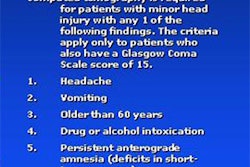Autoimmune pancreatitis is a rare form of pancreatitis characterized by diffuse or focal enlargement of the gland, periductal inflammation, fibrosis, and vasculitis -- often accompanied by other autoimmune disease and nonspecific symptoms.
But according to researchers from Italy, the condition can be reliably characterized on biphasic or triphasic CT. This is good news for patients not only because the commonest differential diagnosis is pancreatic adenocarcinoma, but because autoimmune pancreatitis responds well and rather quickly to corticosteroid treatment. Magnetic resonance cholangiopancreatography (MRCP) and MRI have also been used in the diagnosis.
In their retrospective study, researchers from the department of radiology at the University of Verona Medical School examined 19 patients with histologically proven autoimmune pancreatitis with the aim of determining the CT features, and assessing the changes after high-dose corticosteroid treatment.
"Why do we have to talk about autoimmune pancreatitis? Because the therapy is different from other forms of chronic pancreatitis," said Dr. Riccardo Manfredi at the 2005 RSNA meeting in Chicago. "Mainly we administer corticosteroids, and by far I think the most important thing is the differential diagnosis with tumors, especially in focal forms of the disease."
Diagnosis can be challenging. Most patients present with jaundice and some with abdominal pain and elevated tumor markers. But they typically have no history of alcohol abuse or biliary disease. "So the clinician asks for CT," Manfredi said.
Among the 19 patients (slight male predominance), seven or 37% also had a concurrent autoimmune disease mainly represented by ulcerative rectocolitis, and in two cases by autoimmune thyroiditis.
All were examined using single-slice helical CT, including 12 of the 19 with a biphasic dynamic study and all patients by a triphasic study a mean of 56 days after the initial exam. The more recent cases were also imaged by MRI, Manfredi said.
Two radiologists working independently examined the data qualitatively and quantitatively, assessing enlargement, calcification, vascularization, and contrast retention. The vascularization was analyzed to determine whether it was iso-, hypo-, or hypervascular compared to the renal cortex during the pancreatic phase, Manfredi said. The group also looked for enlargement of the main pancreatic duct and common bile duct. Post-treatment CT was examined for changes in size of the pancreatic parenchyma, the size of the common bile duct and main pancreatic duct, and to assess any changes in vascularization.
The results showed no pancreatic calcification in any patients. There was diffuse enlargement in six patients (32%) and focal enlargement of the pancreas in 13 of the 19 patients (68%), including the head in 10 patients, the body and tail in two patients, and the body only in one. Strong interobserver agreement was also noted.
"As for vascularization, in all cases autoimmune pancreatitis appeared hypovascular during the arterial-pancreatic phase," Manfredi said. Rim enhancement was seen in only three patients. The main pancreatic duct wasn't visible in any patients, whereas in those with focal enlargement, the upstream vessel was dilated in seven (54%) of the patients and normal in six (46%).
Post-treatment there was a marked normalization in size and, with enlargement reduced significantly among diffusely enlarged patients, reduction of only the involved segments in cases of focal enlargement.
CT can readily diagnose autoimmune pancreatitis, even in the presence of nonspecific clinical symptoms, Manfredi concluded.
He noted that the diffuse form of the disease is easier to diagnose than focal enlargement, which may mimic pancreatic adenocarcinoma. When this question cannot be resolved, the group administers high-dose corticosteroid treatment for 15 days and then rescans the patient.
"After 15 days a tumor will not change, and 15 days will not change the patient's prognosis," he said. "If it is autoimmune pancreatitis, there is normalization and we're very happy."
Association with other autoimmune disease
In another recent study, gastroenterologists from Mitsui Memorial Hospital in Tokyo found high rates of pulmonary involvement in autoimmune pancreatitis.
Autoimmune pancreatitis has extrapancreatic complications such as Sjögren's syndrome, retroperitoneal fibrosis, and sclerosing cholangitis, wrote Dr. K. Hirano and colleagues in a study of 30 patients with autoimmune pancreatitis in the Internal Medicine Journal.
"We identified pulmonary involvement in four patients during follow-up," the team wrote. "Among them, two patients had respiratory failure. They showed good response to steroid therapy, but a higher dose of prednisolone was necessary to maintain remission than that required in biliary involvement" (Internal Medicine Journal, January 2006, Vol. 36:1, pp. 58-61).
Elevated immunoglobulin G(4) and Krebs von den Lungen-6 levels were characteristic of pulmonary involvement, and may be useful markers for the early detection of pulmonary complications, Hirano and colleagues concluded.
Another study, by Dr. T. Kamisawa et al from Tokyo Metropolitan Komagome Hospital in Japan, found that autoimmune pancreatitis may be associated with retroperitoneal fibrosis in middle-aged males, who responded favorably to steroidal treatment (Journal of the Pancreas, May 10, 2005, Vol. 6:3, pp. 260-263).
By Eric Barnes
AuntMinnie.com staff writer
February 3, 2006
Related Reading
MRI can track transplanted islet cells in mice, January 3, 2006
CT obviates need for biopsy in pancreatic malignancy, November 28, 2006
3D MRI spots small pancreatic cancers, September 15, 2005
High-intensity focused ultrasound shows promise in pancreatic cancer, August 30, 2005
Fruit, veggies tied to lower pancreatic cancer risk, April 4, 2005
Copyright © 2006 AuntMinnie.com



















